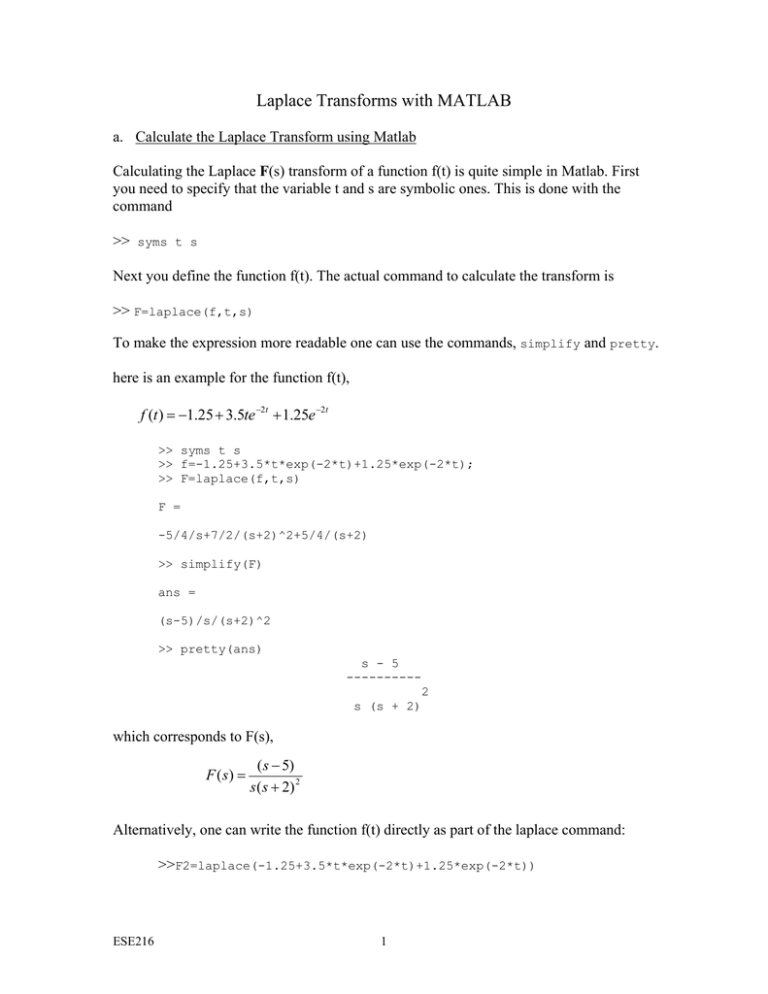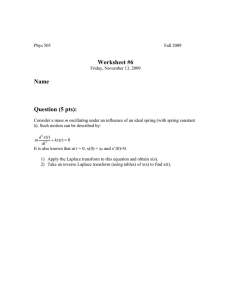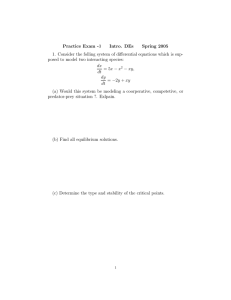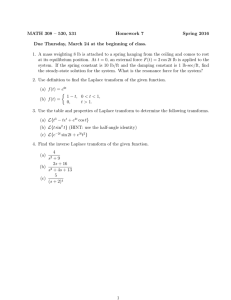Laplace Transforms with MATLAB
advertisement

Laplace Transforms with MATLAB a. Calculate the Laplace Transform using Matlab Calculating the Laplace F(s) transform of a function f(t) is quite simple in Matlab. First you need to specify that the variable t and s are symbolic ones. This is done with the command >> syms t s Next you define the function f(t). The actual command to calculate the transform is >> F=laplace(f,t,s) To make the expression more readable one can use the commands, simplify and pretty. here is an example for the function f(t), f (t ) = −1.25 + 3.5te −2t + 1.25e −2t >> syms t s >> f=-1.25+3.5*t*exp(-2*t)+1.25*exp(-2*t); >> F=laplace(f,t,s) F = -5/4/s+7/2/(s+2)^2+5/4/(s+2) >> simplify(F) ans = (s-5)/s/(s+2)^2 >> pretty(ans) s - 5 ---------2 s (s + 2) which corresponds to F(s), F ( s) = ( s − 5) s ( s + 2) 2 Alternatively, one can write the function f(t) directly as part of the laplace command: >>F2=laplace(-1.25+3.5*t*exp(-2*t)+1.25*exp(-2*t)) ESE216 1 b. Inverse Laplace Transform The command one uses now is ilaplace. One also needs to define the symbols t and s. Lets calculate the inverse of the previous function F(s), F ( s) = ( s − 5) s ( s + 2) 2 >> syms t s >> F=(s-5)/(s*(s+2)^2); >> ilaplace(F) ans = -5/4+(7/2*t+5/4)*exp(-2*t) >> simplify(ans) ans = -5/4+7/2*t*exp(-2*t)+5/4*exp(-2*t) >> pretty(ans) - 5/4 + 7/2 t exp(-2 t) + 5/4 exp(-2 t) Which corresponds to f(t) f (t ) = −1.25 + 3.5te −2t + 1.25e −2t Alternatively one can write >> ilaplace((s-5)/(s*(s+2)^2)) Here is another example. F (s) = 10( s + 2) s ( s 2 + 4s + 5) >> F=10*(s+2)/(s*(s^2+4*s+5)); >> ilaplace(F) ans = -4*exp(-2*t)*cos(t)+2*exp(-2*t)*sin(t)+4 Which gives f(t), f (t ) = [4 − 4e −2t cos(t ) + 2e −2t sin(t )]u (t ) making use of the trigonometric relationship, x sin(α ) + y cos(α ) = R sin(α + β ) and x cos(α ) − y sin(α ) = R cos(α + β ) with R = x2 + y2 β = tan −1 ( y / x) One can also write that f(t) = [4 + 4.47e −2t cos(t − 153.4o )]u (t ) ESE216 2 Matlab often gives the inverse Laplace Transform in terms of sinhx and coshx. Using the following definition one can rewrite the hyperbolic expression as a function of exponentials: ex + e−x sinh( x) = 2 x e − e−x cosh(s ) = 2 Also, you may find the “Heaviside(t) function which corresponds to the unit step function u(t): thus the function H(t) = heaviside(t) =0 for t<0 and H(t) = heaviside(t)=1 for t>0. As an example, suppose that Matlab gives you the following result for the inverse Laplace transform: 2 heaviside(t-10) exp(-5/2t+25) sinh(1/2t-5) This can be re-written, using the definition of the sinh(x) function: 2u(t) e 0.5t −5 − e −2.5t +5 ] = u (t − 10).e −2.5t + 25+0.5t −5 − e −2.5t + 25−0.5t +5 2 −3t + 30 −e ] f (t ) = 2u (t − 10).e − 2.5( t −10 ) [ = u (t − 10)[e − 2t + 20 = [e − 2 ( t −10 ) − e −3( t −10 ) ]u (t − 10) This last expression is closer to what your hand calculations will give you for the invers Laplace Transform. ESE216 3




